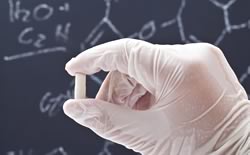Recent News & Events
Scientists Develop New Medications in Much Less Time Using New Crystallographic Method
29
 Researchers at the University of Zurich have developed a unique way to determine the crystal makeup of organic salts faster. Since salts make up about 40 percent of the active ingredients in medications, this new process can significantly accelerate the development of new pharmaceuticals. The new crystallographic method also decreases the effort that scientists put into that process.
Researchers at the University of Zurich have developed a unique way to determine the crystal makeup of organic salts faster. Since salts make up about 40 percent of the active ingredients in medications, this new process can significantly accelerate the development of new pharmaceuticals. The new crystallographic method also decreases the effort that scientists put into that process.
The Current Development Process
Determining the atomic structure of biologically active substances in new drugs is one of the main steps of the medication development process. Scientists generally confirm the three-dimensional setup by performing X-ray analyses of each crystal structure. Along with this process being time-consuming and complex, so is growing the ideal crystals to develop new drugs.
Organic salts are made up of negatively and positively charged particles. These determine the water absorption, solubility, stability, shape and melting point of the organic salts. Until now, searching for a negatively charged anion to pair with the positively charged cation in salts has required an intense amount of resources.
A Trainee Has a Breakthrough
Philipp Nievergelt is a trainee in the Department of Chemistry at UZH and the first author in this study. He spent 10 months in the lab with Professor Berhard Spingler before he made the discovery. The successful junior researcher explained in an interview that he became excited about working in the lab when he earned the traineeship, and it encouraged him to do more.
The Faster, More Efficient Process
After modifying the method for the crystallization of proteins, Spingler and Nievergelt successfully applied the process to organic salts. They've been able to establish the crystal structures of numerous organic salts with less effort and in a shorter amount of time compared to the existing process. Because of that, Spingler clarifies, scientists can develop new medications in much less time.
The UZH researchers have simplified the screening process for organic salts. They're using a semi-automatic combination of vapor diffusion and ion exchange screening for the crystallization process. In addition to speeding it up, this new method makes it cheaper because fewer resources are needed.
Applications in the Health Industry
The benefits that this new crystallographic method will have on the health industry are obvious. As scientists determine the causes of diseases and treatments for them, people won't have to wait as long for medications to be developed. Since the new development process won't require as many resources as the existing process, the new drugs could cost less too. However, it's hard to say at this point when these benefits will trickle down.
